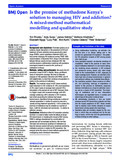| dc.description.abstract | Background and objectives: Promoted globally as an
evidence-based intervention in the prevention of HIV and
treatment of heroin addiction among people who inject
drugs (PWID), opioid substitution treatment (OST) can
help control emerging HIV epidemics among PWID. With
implementation in December 2014, Kenya is the third SubSaharan
African country to have introduced OST. We
combine dynamic mathematical modelling with qualitative
sociological research to examine the ‘promise of
methadone’ to Kenya.
Methods, settingandparticipants: We model the HIV
prevention impact of OST in Nairobi, Kenya, at different
levels of intervention coverage. We draw on thematic
analyses of 109 qualitative interviews with PWID, and 43
with stakeholders, to chart their narratives of expectation in
relation to the promise of methadone.
Results: The modelled impact of OST shows relatively
slight reductions in HIV incidence (5–10%) and prevalence
(2–4%) over 5 years at coverage levels (around 10%)
anticipated in the planned roll-out of OST. However, there
is a higher impact with increased coverage, with 40%
coverage producing a 20% reduction in HIV incidence,
even when accounting for relatively high sexual
transmissions. Qualitative findings emphasise a culture of
‘rationed expectation’ in relation to access to care and a
‘poverty of drug treatment opportunity’. In this context, the
promise of methadone may be narrated as a symbol of
hope—both for individuals and community—in relation to
addiction recovery.
Conclusions: Methadone offers HIV prevention potential,
but there is a need to better model the effects of sexual
HIV transmission in mediating the impact of OST among
PWID in settings characterised by a combination of
generalised and concentrated epidemics. We find that
individual and community narratives of methadone as
hope for recovery coexist with policy narratives positioning
methadone primarily in relation to HIV prevention. Our
analyses show the value of mixed methods approaches to
investigating newly-introduced interventions. | en_US |

